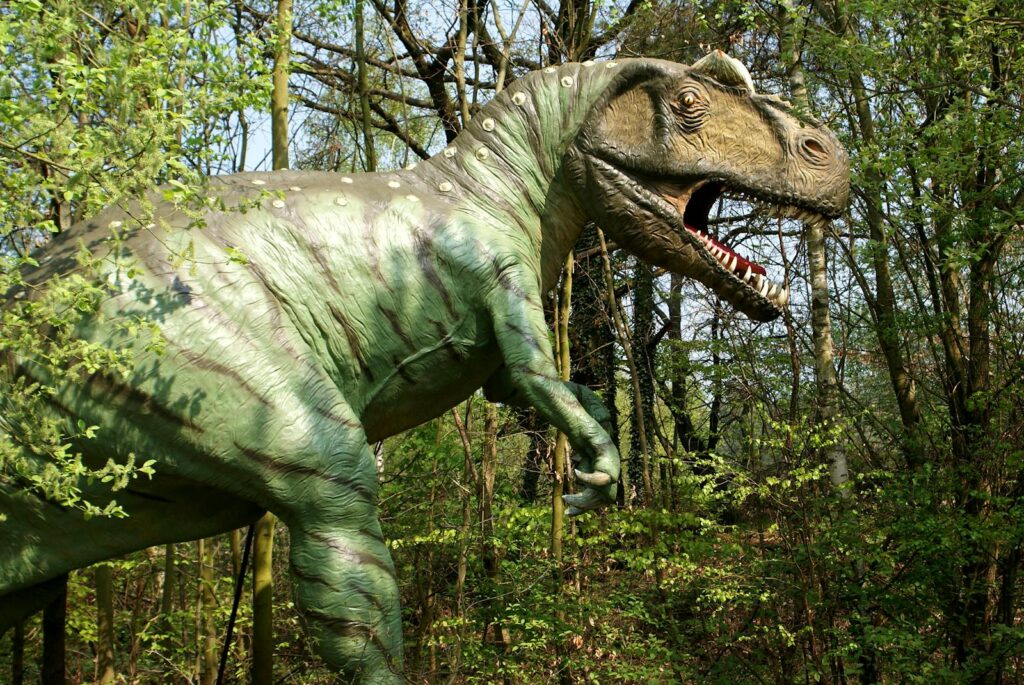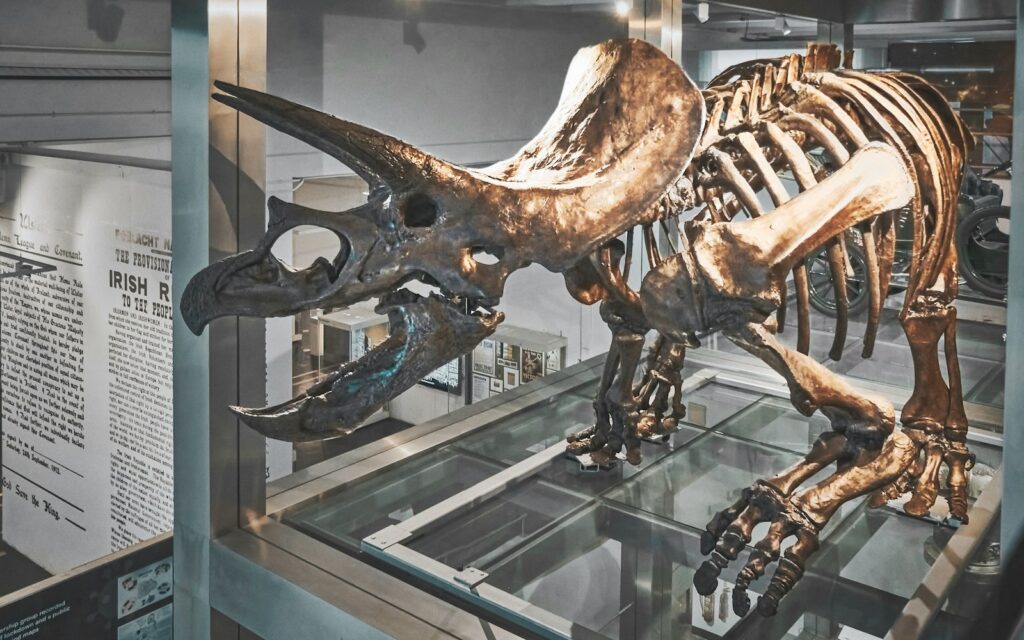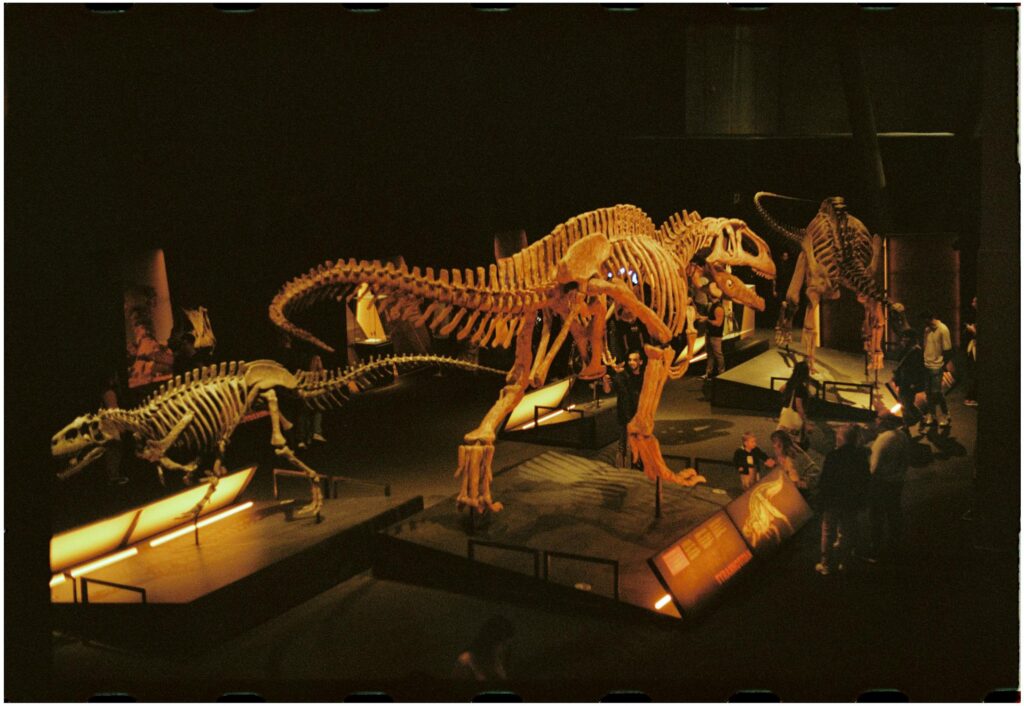For millions of years, dinosaurs dominated Earth, evolving into countless species with diverse capabilities. Their long reign—spanning approximately 165 million years—dwarfs humanity’s brief 300,000-year existence. This stark contrast inevitably raises a fascinating question: if dinosaurs had not been wiped out by the Chicxulub asteroid impact 66 million years ago, could they have eventually developed intelligence comparable to humans and built their own civilizations?
This thought experiment isn’t merely science fiction fodder but offers valuable insights into evolutionary pathways, intelligence development, and the conditions necessary for technological societies to emerge.
The Intelligence Question: How Smart Were Dinosaurs?

Dinosaur intelligence varied tremendously across different species and families. Contrary to earlier assumptions of dinosaurs as universally “dim-witted,” fossil evidence reveals that some possessed relatively large brain-to-body mass ratios. Troodontids, small theropod dinosaurs closely related to birds, had brain-to-body ratios comparable to some modern birds.
Stenonychosaurus, for instance, had a brain approximately six times larger than would be expected for a reptile of its size. Despite these findings, even the most neurologically advanced dinosaurs likely possessed intelligence somewhere between modern reptiles and birds—far from the complex cognitive abilities of primates. Their neural architecture simply wasn’t organized for the type of abstract thinking, tool use, and language development necessary for civilization-building.
Evolutionary Pressures and Intelligence

Intelligence doesn’t evolve in a vacuum but responds to specific environmental pressures. For humans, intelligence likely developed as an adaptation to complex social structures, changing environments, and the advantages of tool use. Most dinosaur species faced different selective pressures that favored physical adaptations like size, speed, or specialized feeding mechanisms over cognitive development.
Predatory dinosaurs evolved keen senses and physical prowess, while herbivores developed defensive features or herd behaviors. The evolutionary trajectory toward higher intelligence requires specific conditions that may have been absent or insufficient during the dinosaurs’ reign. Without these particular pressures consistently applied over millions of years, the path toward human-like intelligence would be highly improbable.
The Troodon Hypothesis: The Most Likely Candidate

If any dinosaur lineage had potential for developing advanced intelligence, many paleontologists point to the troodontids. Troodon formosus possessed several promising characteristics: relatively large brains for their body size, stereoscopic vision suggesting complex environmental processing, and grasping hands potentially capable of manipulating objects.
Canadian paleontologist Dale Russell famously speculated about the “dinosauroid”—a thought experiment imagining Troodon’s potential evolution had the extinction event not occurred. His hypothetical creature featured an upright posture, enlarged cranium, and humanoid appearance. However, most modern paleontologists consider this anthropomorphized vision highly speculative and unlikely. Convergent evolution rarely produces such direct human analogues, and intelligence can manifest in forms quite different from our own.
Physical Limitations: Hands, Manipulation, and Technology

The development of civilization requires not just intelligence but also the physical capability to manipulate the environment. The human hand, with its opposable thumb and fine motor control, provided a crucial platform for tool development. Among dinosaurs, even the most dexterous theropods had fundamental limitations in their forelimb structure. Dromaeosaurs like Velociraptor possessed three-fingered hands capable of grasping, but these were still primarily adapted for predation rather than fine manipulation.
The physical architecture necessary for crafting and using complex tools—a prerequisite for technological development—was limited even in the most manually adept dinosaur species. Without the ability to build, modify, and precisely control tools, the technological foundation for civilization would remain out of reach regardless of cognitive potential.
Social Structures and Cooperation

Human civilization depended heavily on complex social structures, cooperation, and knowledge transfer between individuals and generations. Evidence suggests that some dinosaur species, particularly certain theropods and hadrosaurs, exhibited social behaviors and possibly lived in groups. The nesting grounds of Maiasaura show potential parental care, while trackways indicate herding behaviors in various species.
However, the fossil record provides limited evidence for the type of complex, hierarchical social structures that facilitated human cultural development. The capacity for teaching, collective problem-solving, and cultural accumulation of knowledge—all critical for civilization—would require social and cognitive adaptations beyond what we can confidently attribute to even the most social dinosaur species. Without these social foundations, technological progress would likely stall at primitive levels.
Avian Dinosaurs: Intelligence That Survived

Interestingly, dinosaurs did not completely disappear—birds are technically avian dinosaurs that survived the mass extinction. Modern birds, particularly corvids (ravens, crows) and psittacines (parrots), demonstrate remarkable intelligence, including tool use, problem-solving abilities, and, in some cases, rudimentary language capabilities. New Caledonian crows craft specialized tools, while African grey parrots can understand numerical concepts and communicate using hundreds of words.
These cognitive abilities evolved in relatively small-bodied, flight-adapted descendants of theropod dinosaurs, suggesting that the extinction event may have inadvertently selected for lineages with greater cognitive potential. The intelligence of modern birds provides a window into how dinosaur cognition could evolve under the right circumstances, though even these impressive capabilities fall short of what would be necessary for civilization-building.
The Time Factor: Could 66 Million More Years Have Made a Difference?

Evolution operates through incremental changes over vast time periods. With an additional 66 million years—the time between the dinosaur extinction and present day—could dinosaurs have evolved human-level intelligence? This timeframe is certainly substantial, considering that humans and chimpanzees diverged only about 6-7 million years ago. However, evolutionary change isn’t predictable or directional—intelligence doesn’t inevitably increase over time. Without specific selective pressures favoring cognitive development, additional time alone wouldn’t guarantee dinosaurs would evolve civilization-building capabilities.
The evolutionary trajectory would depend on countless environmental factors, ecological relationships, and random mutations. While 66 million years provides ample opportunity for significant evolution, there’s no evidence suggesting dinosaur lineages were on a cognitive trajectory that would ultimately lead to civilization-building intelligence.
Alternative Evolutionary Pathways

If dinosaurs had continued evolving without the extinction event, they might have developed forms of intelligence fundamentally different from our own. Intelligence isn’t a linear progression culminating in human-like cognition but can manifest in diverse ways suited to different environmental contexts. Cephalopods like octopuses developed remarkable problem-solving abilities through a completely different evolutionary pathway than vertebrates, with distributed neural systems rather than centralized brains.
Hypothetical advanced dinosaur cognition might have emphasized different capabilities—perhaps extraordinary spatial memory, sensory processing, or forms of communication based on movement or color changes rather than abstract language. Such alternative cognitive architectures might enable complex behaviors and adaptations without necessarily leading to technological civilization as humans understand it.
Resource Utilization and Energy Requirements

Civilization requires not just intelligence and manipulative ability but access to and control of energy sources. Human technological development depended on the ability to harness fire, develop agriculture, and eventually exploit fossil fuels. The metabolic requirements of dinosaurs—particularly large-bodied species—would have presented different energy challenges than those faced by mammals. Many dinosaurs were ectothermic or had intermediate metabolisms, potentially limiting the energy available for brain development.
While smaller, potentially endothermic theropods might have overcome these limitations, the fundamental energy economics of dinosaur physiology could have influenced cognitive evolution. Additionally, the ability to control fire—perhaps the most crucial technology enabling human civilization—would be particularly challenging for species without specialized manipulation capabilities or cultural mechanisms for preserving and transporting flame.
Environmental Factors and External Pressures

The Mesozoic Era presented environmental conditions substantially different from those that shaped human evolution. Atmospheric oxygen and carbon dioxide levels fluctuated significantly, with generally higher temperatures and no polar ice caps during much of the dinosaurs’ reign. These conditions influenced available ecosystems, metabolic possibilities, and adaptive pressures. Human intelligence evolved partly in response to rapidly changing environments during the Pleistocene, with climate fluctuations driving adaptability and problem-solving.
The relatively stable ecosystems of the late Cretaceous might have provided less selective pressure for the type of adaptive intelligence that characterizes humans. Environmental stability can favor specialization rather than the generalist adaptations that often accompany cognitive flexibility. Without equivalent environmental challenges, dinosaur evolution might have continued favoring physical adaptations over cognitive ones.
Parallel Evolution in Mammals

While dinosaurs dominated the Mesozoic, mammals existed alongside them for over 150 million years, generally remaining small and occupying specialized ecological niches. Following the dinosaur extinction, mammals underwent explosive adaptive radiation, eventually producing numerous intelligent lineages including primates, cetaceans, and elephants. This parallel evolutionary track raises an interesting question: if conditions favored intelligence evolution, why didn’t it happen more prominently among Mesozoic mammals?
The persistence of small-bodied, relatively simple mammalian forms throughout the dinosaur era suggests that ecological conditions simply didn’t favor the evolution of large-brained, tool-using species. The absence of highly intelligent mammals during this period indirectly suggests that environmental conditions, rather than just the dominance of dinosaurs, may have been unsuitable for the evolution of civilization-building intelligence during the Mesozoic.
Technological Traces: Would We Know If Dinosaur Civilizations Existed?

A fascinating thought experiment involves considering whether we would recognize evidence of a dinosaur civilization had one existed in Earth’s distant past. Human civilization has existed for roughly 10,000 years—a geological blink of an eye—yet has already left profound marks on the planet through infrastructure, pollution, and resource extraction. Over the vastness of geological time, most physical evidence of technology would degrade, with even sophisticated structures likely disappearing within a few million years through erosion, plate tectonics, and other geological processes.
However, certain signatures would likely persist: abnormal concentrations of rare elements in geological strata, evidence of non-natural isotope ratios, or traces of artificial materials. The complete absence of such anomalies in Mesozoic geological layers strongly suggests no technological civilization existed during the dinosaurs’ reign.
Conclusion: The Improbable Dinosaur Civilization

While the concept of dinosaur civilizations captivates our imagination, scientific evidence suggests it remains firmly in the realm of speculative fiction rather than evolutionary possibility. The cognitive capabilities, physical limitations, social structures, and environmental contexts of dinosaurs created an evolutionary landscape unfavorable to the development of technology-building intelligence. This doesn’t diminish the remarkable adaptations and evolutionary success of dinosaurs, who dominated Earth’s ecosystems for far longer than humans have existed.
Perhaps the most profound insight from this thought experiment is recognizing how contingent our own civilization is on specific evolutionary pathways, physical capabilities, and environmental circumstances. Human-style intelligence and technological civilization represent just one possible outcome in the vast landscape of evolutionary possibility—a reminder of both the remarkable nature of our own existence and the diverse forms intelligence might take in the universe.




